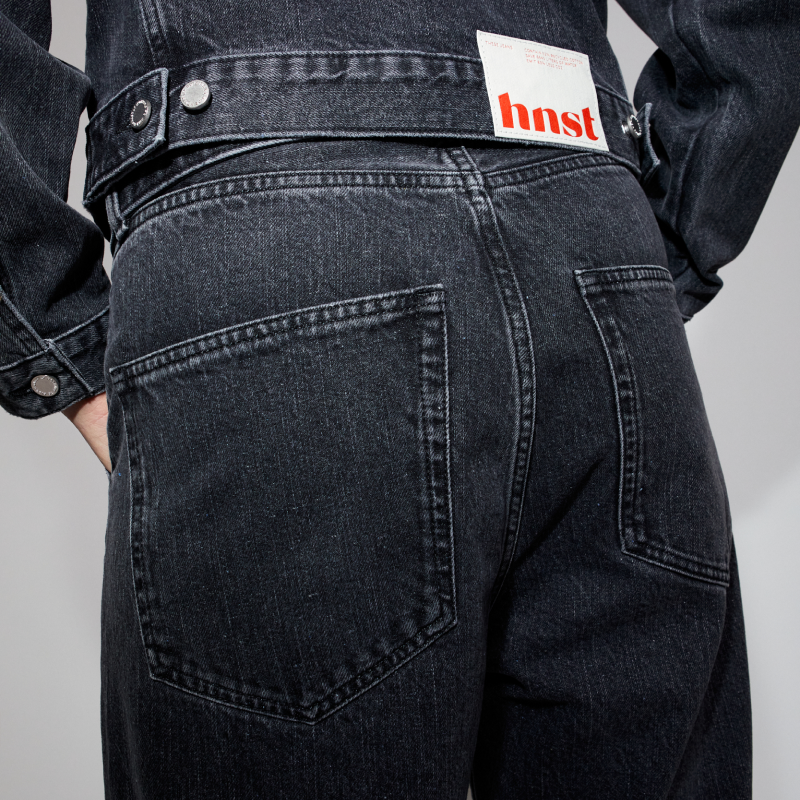
name:
HNST
founded:
2018
origin:
Belgium
Belgian denim brand HNST was founded as a circular fashion brand. In 2022, its entire jeans collection was produced in line with The Jeans Redesign guidelines.
What they do
HNST takes inspiration from the idea that in nature nothing is wasted, with circular design sitting at the heart of the brand’s strategic direction. “All HNST products are produced using entirely circular methods,” says Product & Sustainability Manager, Eva Engelen; “they contain between 50-80% recycled materials and are designed for efficient recycling at the end of life.”
The company has also invested in partnerships with suppliers to create new materials and trims, such as unscrewable buttons that can be removed from the jeans after use and bar tacks that maintainmaintainKeep a product in its existing state of quality, functionally and/or cosmetically, to guard against failure or decline. It is a practice that retains the highest value of a product by extending its use period. durabilitydurabilityThe ability of a product, component or material to remain functional and relevant when used as intended. without rivets. Opting for these trims means the jeans can be taken apart more easily at the end of their life for remaking and recycling.
Since 2019, HNST's internal circular design guidelines have fully aligned with The Jeans Redesign guidelines. The company’s entire jeans portfolio is produced in accordance with The Jeans Redesign guidelines. This means all their jeans can withstand a minimum of 30 home laundries; more than 50% of the cotton used is recycled; and garment labelling provides information on material content to make them easier to sort and recyclerecycleTransform a product or component into its basic materials or substances and reprocessing them into new materials..
HNST has also begun to apply circular design principles beyond jeans, bringing T-shirts to market in 2021 made with 80% pre-consumer recycled material sourced from Portugal. During 2023, they designed a collection of denim jackets, overshirts, and overalls in line with The Jeans Redesign guidelines.


Why it’s an example of the circular economy
Jeans are one of the highest impact products in the fashion industry. When produced using traditional methods, denim is extremely water, energy, and chemical intensive. Yet despite the significant resources that go into producing clothes, we’re wearing them less than ever. Between 2000 and 2015, global clothing production doubled: in the same fifteen years, clothing utilisation - the average number of times a garment is worn before it ceases to be used - decreased by 36%.
By designing jeans to be durable, HNST is keeping the materials in use at their highest value for as long as possible. Durability takes two forms. Physical durability is a garment’s ability to resist damage; emotional durability is the product’s ability to stay relevant and desirable. Both are equally important in a circular economycircular economyA systems solution framework that tackles global challenges like climate change, biodiversity loss, waste, and pollution. It is based on three principles, driven by design: eliminate waste and pollution, circulate products and materials (at their highest value), and regenerate nature..
All clothes will eventually wear out, but often the way jeans are designed and constructed in a linear system makes them difficult to remake and recycle after use. Complex fibre structures and components (such as rivets) make it difficult to reintroduce those materials into the circular economy. By sourcing disassemblable components and providing clear labelling on the material content, HNST is making it easier to reusereuseThe repeated use of a product or component for its intended purpose without significant modification. the resources contained within jeans. In addition, choosing to use recycled fibres in their collection ensures high-value materials are reprocessed and turned into new products, minimising the use of virgin resources and maximising the use of materials.
In the European Commission’s 2030 Vision for Textiles, all textile products placed on the EU market are: durable, repairable and recyclable. This aligns with our vision for a circular economy for fashion. By already designing and producing garments that are created from safe and renewable inputs, can be used more, and are made to be made again, HNST is proving that it is possible to design and make clothes fit for a circular economy.







